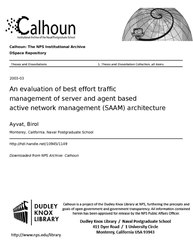File:An evaluation of best effort traffic management of server and agent based active network management (SAAM) architecture (IA anevaluationofbe109451149).pdf

Original file (1,275 × 1,650 pixels, file size: 748 KB, MIME type: application/pdf, 106 pages)
Captions
Captions
Summary[edit]
| An evaluation of best effort traffic management of server and agent based active network management (SAAM) architecture
( |
||
|---|---|---|
| Author |
Ayvat, Birol |
|
| Title |
An evaluation of best effort traffic management of server and agent based active network management (SAAM) architecture |
|
| Publisher |
Monterey, California. Naval Postgraduate School |
|
| Description |
The Server and Agent-based Active Network Management (SAAM) architecture was initially designed to work with the next generation Internet where increasingly sophisticated applications will require QoS guarantees. Although such QoS traffic is growing in volume, Best Effort traffic, which does not require QoS guarantees, needs to be supported for foreseeable future. Thus, SAAM must handle Best Effort traffic as well as QoS traffic. A Best Effort traffic management algorithm was developed for SAAM recently to take advantage of the abilities of the SAAM server. However, this algorithm has not been evaluated quantitatively. This thesis conducts experiments to compare the performance of the Best Effort traffic management scheme of the SAAM architecture against the well known MPLS Adaptive Traffic Engineering (MATE) Algorithm. A couple of realistic network topologies were used. The results show while SAAM may not perform as well as MATE with a fixed set of paths, using SAAM's dynamic path deployment functionality allows the load to be distributed across more parts of the network, thus achieving better performance than MATE. Much of the effort was spent on implementing the MATE algorithm in SAAM. Some modifications were also made to the SAAM code based on the experimental results to increase the performance of SAAM's Best Effort solution. Subjects: Computer networks; Management |
|
| Language | English | |
| Publication date | March 2003 | |
| Current location |
IA Collections: navalpostgraduateschoollibrary; fedlink |
|
| Accession number |
anevaluationofbe109451149 |
|
| Source | ||
| Permission (Reusing this file) |
This publication is a work of the U.S. Government as defined in Title 17, United States Code, Section 101. As such, it is in the public domain, and under the provisions of Title 17, United States Code, Section 105, it may not be copyrighted | |
Licensing[edit]
| Public domainPublic domainfalsefalse |
This work is in the public domain in the United States because it is a work prepared by an officer or employee of the United States Government as part of that person’s official duties under the terms of Title 17, Chapter 1, Section 105 of the US Code.
Note: This only applies to original works of the Federal Government and not to the work of any individual U.S. state, territory, commonwealth, county, municipality, or any other subdivision. This template also does not apply to postage stamp designs published by the United States Postal Service since 1978. (See § 313.6(C)(1) of Compendium of U.S. Copyright Office Practices). It also does not apply to certain US coins; see The US Mint Terms of Use.
|
 | |
| This file has been identified as being free of known restrictions under copyright law, including all related and neighboring rights. | ||
https://creativecommons.org/publicdomain/mark/1.0/PDMCreative Commons Public Domain Mark 1.0falsefalse
File history
Click on a date/time to view the file as it appeared at that time.
| Date/Time | Thumbnail | Dimensions | User | Comment | |
|---|---|---|---|---|---|
| current | 10:34, 14 July 2020 |  | 1,275 × 1,650, 106 pages (748 KB) | Fæ (talk | contribs) | FEDLINK - United States Federal Collection anevaluationofbe109451149 (User talk:Fæ/IA books#Fork8) (batch 1993-2020 #6979) |
You cannot overwrite this file.
File usage on Commons
The following page uses this file:
Metadata
This file contains additional information such as Exif metadata which may have been added by the digital camera, scanner, or software program used to create or digitize it. If the file has been modified from its original state, some details such as the timestamp may not fully reflect those of the original file. The timestamp is only as accurate as the clock in the camera, and it may be completely wrong.
| Short title | An evaluation of best effort traffic management of server and agent based active network management (SAAM) architecture |
|---|---|
| Author | Ayvat, Birol |
| Software used | Ayvat, Birol |
| Conversion program | Acrobat PDFWriter 5.0 for Windows NT |
| Encrypted | no |
| Page size | 612 x 792 pts (letter) |
| Version of PDF format | 1.4 |

